Webflow and Elementor are popular website builders, each excelling in its own way. Webflow offers advanced design freedom, while Elementor excels in WordPress’s simplicity and ease of use.
Webflow is ideal for professionals, and Elementor works best for small business owners, freelancers, and beginners.
However, both platforms enable users to create professional websites without coding skills. They offer drag-and-drop functionality, templates, and design customization options for different needs.
This guide compares Webflow and Elementor across pricing, features, ease of use, templates, and performance to help you choose the right platform for your needs.
Key Difference: Webflow vs Elementor
Webflow is a complete website-building platform that includes built-in hosting, whereas Elementor is a WordPress plugin that requires separate hosting and WordPress installation.
| Parameter | Webflow | Elementor |
|---|---|---|
| Overview | All-in-one SaaS website builder | WordPress page builder plugin |
| Starting price | $14/month (Basic) | $4.99/month (Essential) |
| Ease of use | Moderate, Ideal for developers | Beginner friendly |
| Hosting | Included | Need separate hosting |
| Design Flexibility | High, with a visual CSS editor | High, advanced customization |
| CMS functionality | Built-in | Present, via WordPress CMS |
| Templates | Professional, responsive | Wide variety |
| E-commerce | Built-in eCommerce features | Available via the WooCommerce plugin |
| Free version | Available, with limitations | Free core version |
| Best For | Designers, developers, freelancers, etc. | Beginners, WordPress users, etc. |
Webflow Vs Elementor: A Quick Overview
Webflow offers advanced design tools for professionals, while Elementor provides an easy, user-friendly platform ideal for beginners and small businesses.
Webflow Overview
Webflow is an all-in-one website builder that enables you to design, build, and launch fully custom websites without requiring coding.
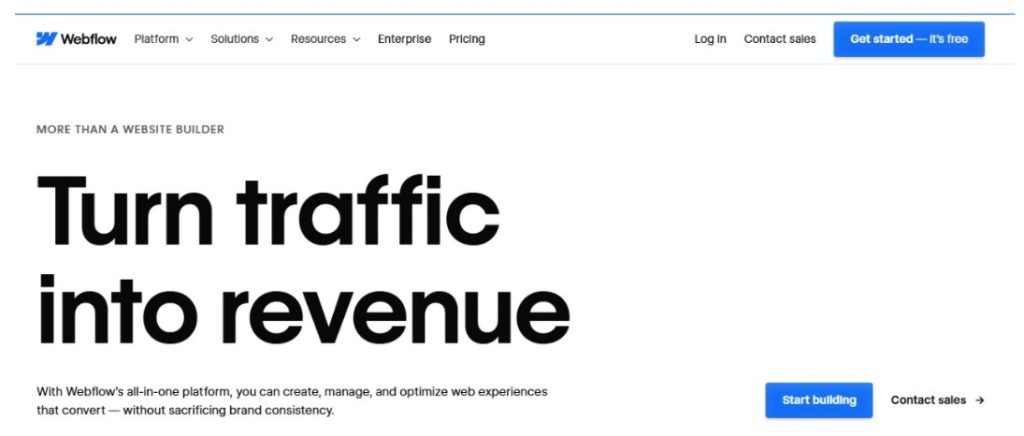
It includes built-in hosting, a visual CMS, eCommerce tools, and flexible design controls for developers and designers.
Elementor Overview
Elementor functions as a WordPress page builder plugin that transforms how users create WordPress websites.
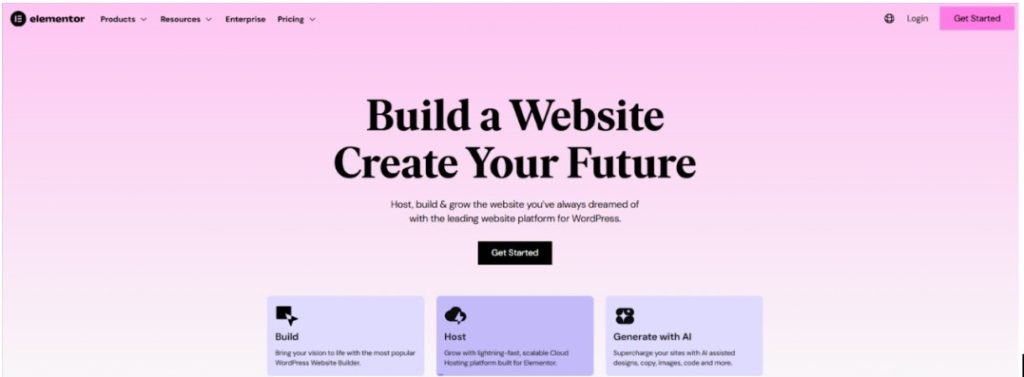
It helps users build pages with drag-and-drop tools. It does not include hosting, but it is simple for anyone familiar with WordPress.
Pricing Plans: Webflow Vs Elementor
Both platforms offer tiered pricing structures that cater to different user needs, ranging from individual projects to large-scale business requirements with varying feature sets.
Webflow Pricing
Webflow offers two main pricing categories: general site plans for standard websites and specialized e-commerce plans for online stores.
General Plan
General plans provide hosting and design tools for creating standard websites without e-commerce functionality or advanced business features.
| Pricing Plan | Monthly | Yearly |
|---|---|---|
| Free | Free | Free |
| Basic | $18/month | $14/month |
| CMS | $29/month | $23/month |
| Business | $49/month | $39/month |
| Enterprise | Not Specified | Not Specified |
Free Plan: This Plan is great for beginners to explore Webflow’s features. Includes basic hosting, two pages, limited CMS items, and form submissions on a Webflow.io domain, ideal for experimenting and prototyping.
Basic Plan: The Basic plan is perfect for simple personal websites, portfolios, or MVPs. Offers custom domain, up to 150 pages, 10 GB bandwidth, unlimited forms, and surge protection, but no CMS or dynamic content.

CMS Plan: The CMS plan is designed for content-driven websites like blogs and marketing pages. Includes structured CMS access, 2,000 items, 20 collections, more bandwidth, site search, and limited team collaboration options.
Business Plan: Business plan built for high-traffic and scaling businesses. Supports 10,000 CMS items, 300 pages, large bandwidth, more team users, file uploads, and advanced hosting for consistent, fast performance and team growth.
Enterprise Plan: This plan is tailored for large teams and businesses with demanding needs. Offers enterprise-level hosting, top security, advanced collaboration, guaranteed uptime (SLA), premium support, and tools for large-scale site performance and control.
E-commerce Plan
E-commerce plans include online store functionality with payment processing, inventory management, and specialized tools for selling products online.
| Pricing Plan | Monthly | Yearly |
|---|---|---|
| Standard | $42/month | $29/month |
| Plus | $84/month | $74/month |
| Advanced | $235/month | $212/month |
Standard Plan: Standard E-commerce plan is Ideal for new online businesses. Supports up to 500 products, 2,000 CMS items, and includes CMS plan features with a 2% transaction fee, great for small, growing eCommerce stores.
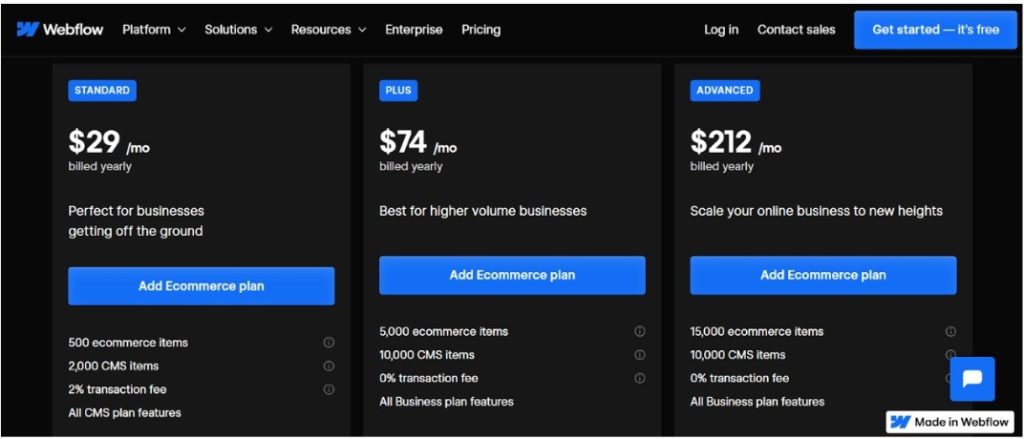
Plus Plan: This plan is suited for mid-sized eCommerce businesses. Offers 5,000 products, 10,000 CMS items, zero transaction fees, and all Business plan features, designed for higher-volume, more established online shops.
Advanced Plan: The Advanced Plan is built for large-scale online retailers. Supports 15,000 products, maximum CMS usage, zero transaction fees, and advanced performance features from the Business plan, perfect for scaling and high-traffic eCommerce sites.
Elementor Pricing
Elementor pricing offers a free version with basic page-building features, while its premium plans unlock advanced widgets, templates, and professional tools for more powerful website creation.
| Pricing Plan | Monthly | Yearly |
|---|---|---|
| Essential | $4.99/month | $60/month |
| Advanced Solo | $6.99/month | $84/month |
| Advanced | $8.25/month | $99/month |
| Expert | $16.99/month | $204/month |
| Agency | $33.25/month | $399/month |
Both the Free and Pro plans of Elementor offer a wide range of features for users. Free is suitable for new users, while Pro is best suited for experienced users and teams.
Essential: This plan includes support, 57 pro widgets, 10 cloud templates, theme builder, dynamic content, and form builder. Popup builder, custom code, and eCommerce features are not included.
Advanced Solo: The Advanced solo plan is designed for one professional or eCommerce site. This plan adds 86 pro widgets, 20 cloud templates, a popup builder, custom code, eCommerce features, and collaborative notes, along with full support.
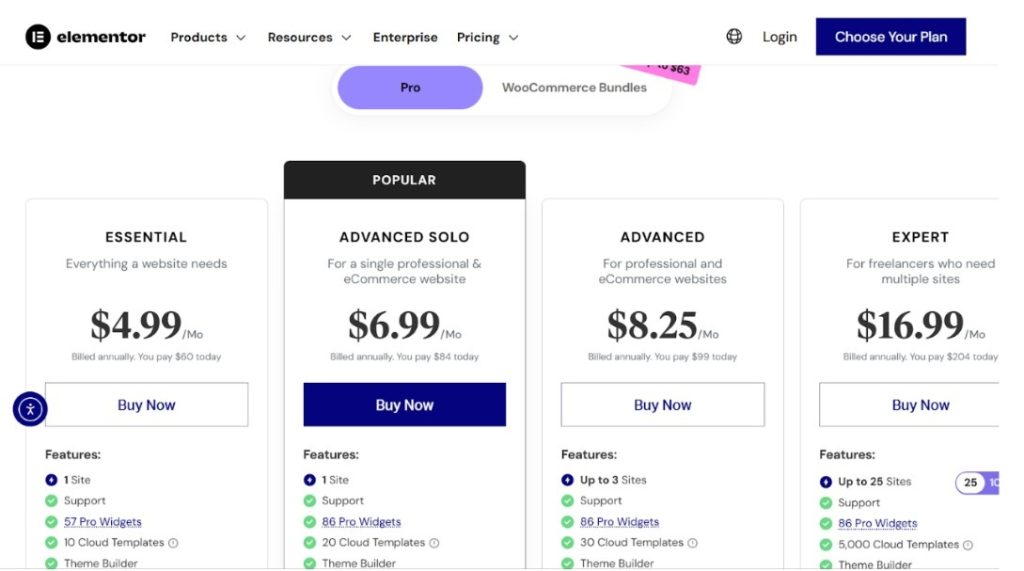
Advanced: This plan supports up to 3 websites with all features of Advanced Solo, plus 30 cloud templates. It is ideal for professionals managing multiple sites, offering complete design and eCommerce tools.
Expert: Expert plan managing up to 25 sites, offering all advanced features plus access to 5,000 cloud templates. Includes full support, theme builder, popups, dynamic content, and collaborative notes.
Agency: This plan supports up to 1,000 sites and includes all advanced features, such as 86 professional widgets, 50,000 cloud templates, theme builder, dynamic content, pop-ups, custom code, eCommerce tools, and collaborative notes, with full support.
Although Elementor does not offer a free trial, but all hosting and Pro plans come with a 30-day money-back guarantee.
Key Features: Elementor vs Webflow
Both platforms offer powerful website-building capabilities but differ in their approach, target audience, and specific features available to users.
1. Available Tools
Both Webflow and Elementor offer powerful tools for designing, building, and managing websites with ease, catering to diverse user needs and technical skills.
Weblow Tools
Webflow lets you build and manage websites easily without needing to code. It offers tools for designing your site, adding and editing content, and optimizing your site for search engines. You can connect your site with many other apps, keep it secure, and make sure it loads fast.
Main Webflow Tools:
- Webflow Designer (for building your site)
- Webflow Editor (for editing content)
- CMS Collections (manage blog posts, products, etc.)
- Integrations with many apps like Mailchimp and Stripe
- SEO controls (titles, descriptions, URLs)
- Image compression and code cleanup
- Automatic backups
- Free SSL for security
- Marketplace with templates and extra features
Elementor Tools
Elementor is a tool that works with WordPress to help you create websites by dragging and dropping elements. It uses WordPress’s plugins and themes to add more features. You can also add animations, improve your site’s SEO, and find many extra add-ons to customize your site.
Main Elementor Tools:
- Drag-and-drop page builder
- Works with WordPress plugins and themes
- Supports dynamic content
- SEO tools (titles, image tags)
- Animation options (fade, slide, hover)
- Add-ons marketplace with extra features
- Form and pop-up builders
- Theme builder and custom code options
2. Ease of Use
Webflow is powerful but takes time to learn. Its interface uses web design terms and concepts like CSS, flexbox, and grids. It requires a basic understanding of design principles and web development concepts. It’s best suited for users with some design or development background who want full creative control
Elementor is beginner-friendly, thanks to its simple interface and live preview. Beginners can quickly learn to create professional websites without prior technical knowledge or coding skills. Additionally, Elementor AI also helps generate content, suggest design improvements, and make website creation even faster.
3. Design Flexibility
Webflow’s visual editor and Style Manager allow precise control over typography, colors, and spacing. With the Interactions Panel, users can create complex animations and transitions, enabling highly customized, professional websites without writing code.
Elementor supports features like Flexbox Containers, Theme Builder, and Global Widgets, making it easy to design responsive, dynamic websites without coding, ideal for beginners and professionals alike.
4. Templates
Webflow offers a wide range of customizable HTML website templates designed for various industries, including tech, real estate, and creative portfolios. Templates are responsive, modern, and include both free and premium options. Each design is built with Webflow tools, making it easy to launch polished, professional websites quickly and efficiently.

Elementor offers over 100 fully designed website kits across various categories, including business, personal, e-commerce, and industry-specific needs. These responsive templates can be quickly customized using Elementor’s intuitive drag-and-drop builder. If you’re a beginner or professional, it’s easy to edit, publish, and go live without any coding skills.
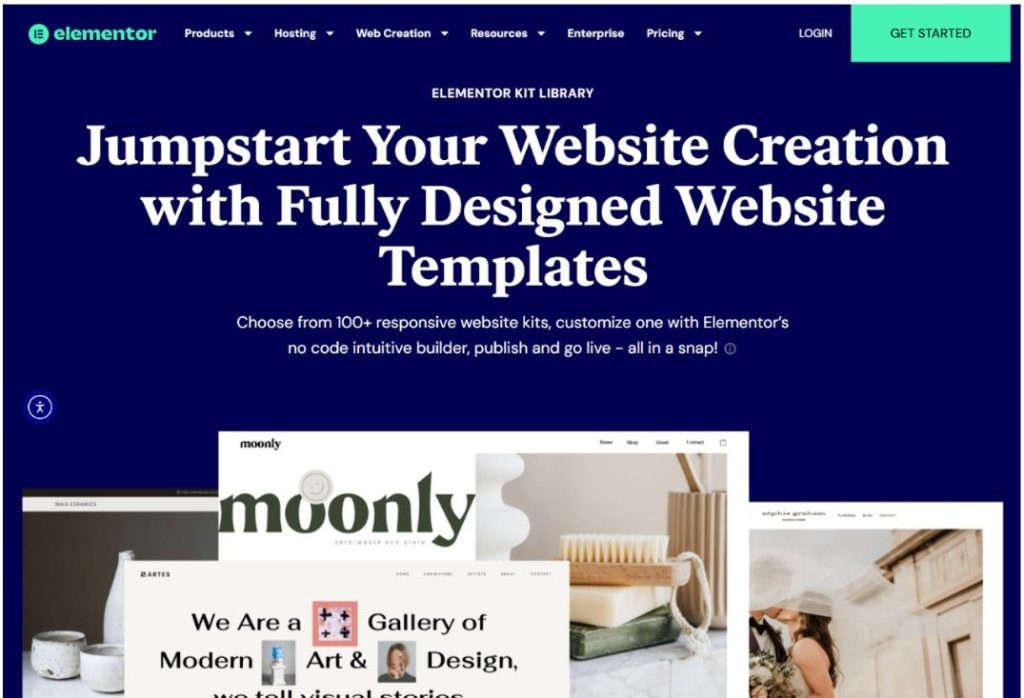
5. Performance & Speed
Webflow sites are hosted on fast, reliable servers with built-in features like code minification and image compression. This gives them a performance edge right out of the box. Pages generally load quickly, and you don’t need extra plugins to optimize speed; it’s all handled automatically.
Elementor websites rely on WordPress, so their performance can vary depending on your hosting and the plugins you use. With the right setup, it can load fast, but using too many widgets or add-ons may slow things down. Tools like caching plugins and image optimization help improve overall speed.
6. Integrations And Add-ons
Webflow has a rich marketplace of powerful apps and tools created by its community. You can easily connect your site to services such as calendars, payment processors, email marketing tools, social media feeds, and even translation tools. Many integrations help automate tasks, manage e-commerce, add animations, and enhance site functionality.
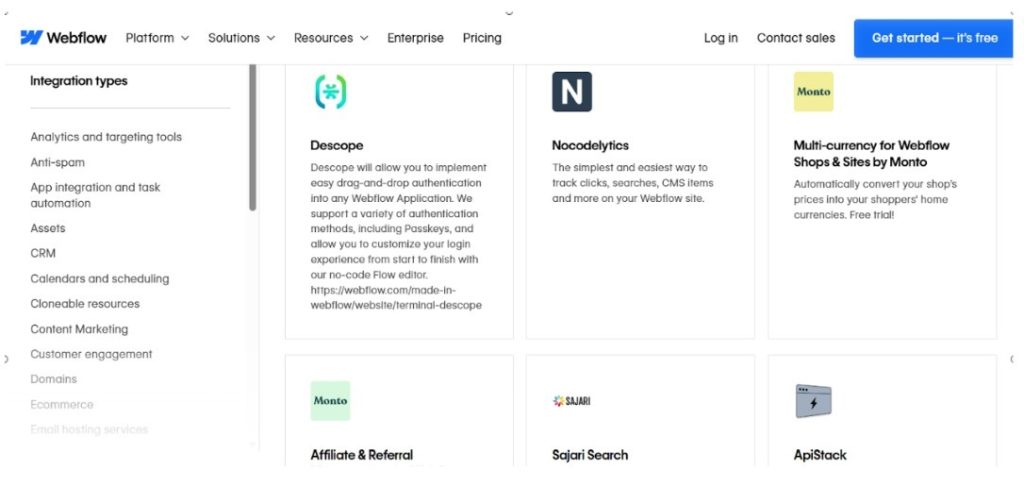
Some integrations with Webflow include:
- Nocodelytics
- Zapier
- Mailchimp
- Stripe
- Google Analytics
- Typeform
Elementor works smoothly with many popular tools and integrations. These integrations enable you to link Elementor with marketing services like Mailchimp and ActiveCampaign, social networks like Facebook and Slack, and essential WordPress plugins, including WooCommerce for online stores and Yoast for SEO.
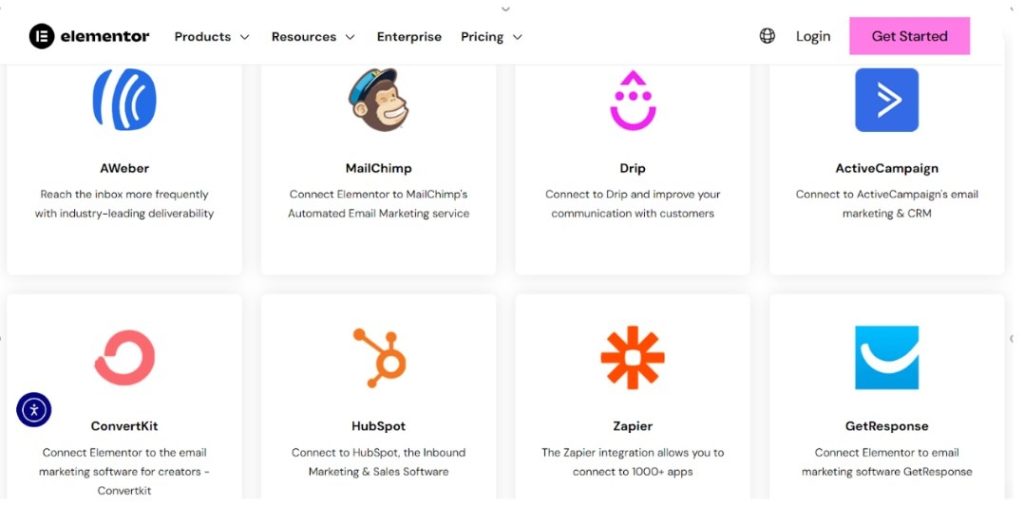
Some integrations with Elementor include:
- WooCommerce
- Yoast SEO
- MailChimp and ActiveCampaign
- reCAPTCHA
- Google Maps
- Zapier
7. SEO Tools
Webflow provides comprehensive built-in SEO features, including schema markup, automated meta titles and descriptions, easy sitemap control, and 301 redirect management. Paired with fast, secure AWS-powered hosting and a flexible CMS, it enables users to optimize their websites efficiently without relying on plugins or technical expertise.
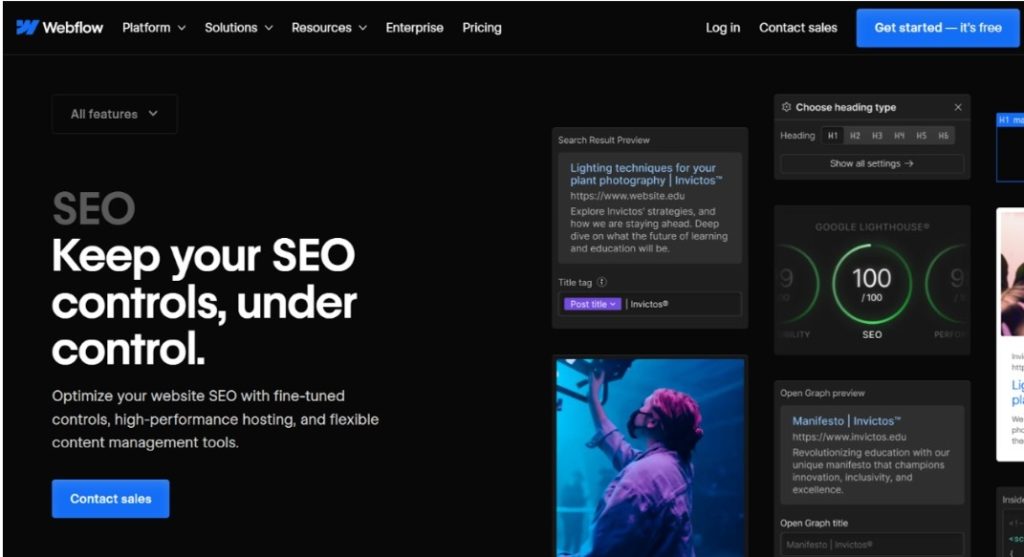
Elementor, combined with WordPress, offers powerful SEO capabilities through popular plugins like Yoast SEO and Rank Math. These tools offer real-time content analysis, automated sitemap generation, schema markup, and bulk SEO editing, enabling users to optimize their sites effectively for improved search engine rankings.
8. E-commerce Capabilities
Webflow’s ecommerce platform enables you to create unique, fully customized online stores without coding.
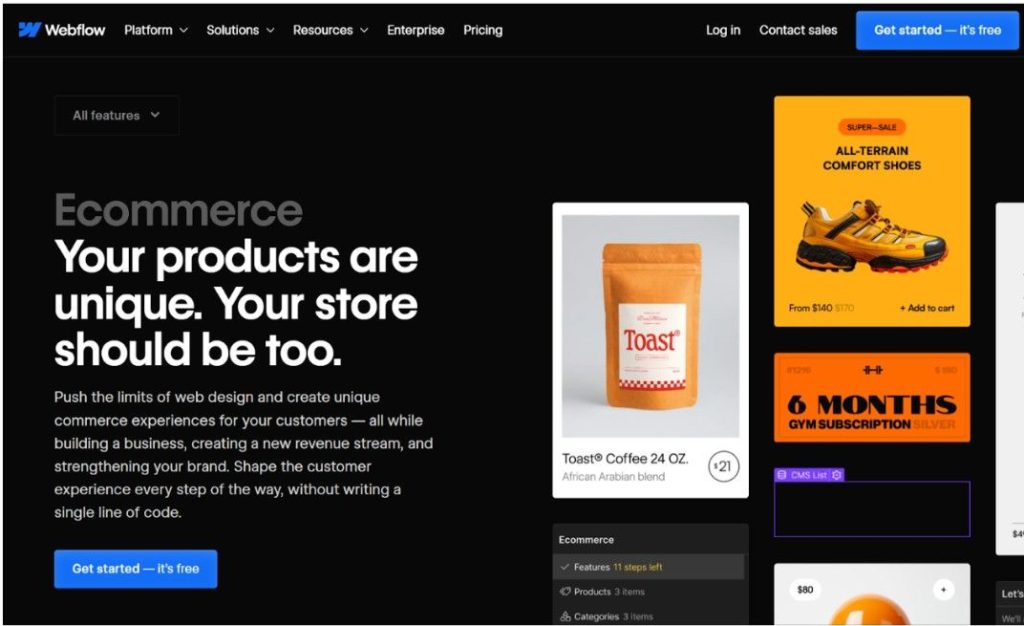
You can sell physical or digital products, customize delivery and payment options, manage orders, automate taxes, and extend functionality with integrations. Webflow also supports marketing tools, SEO automation, and social media integration to grow your business efficiently.
Elementor’s e-commerce website builder offers a complete solution to create and customize online stores with full design freedom using a live editor.
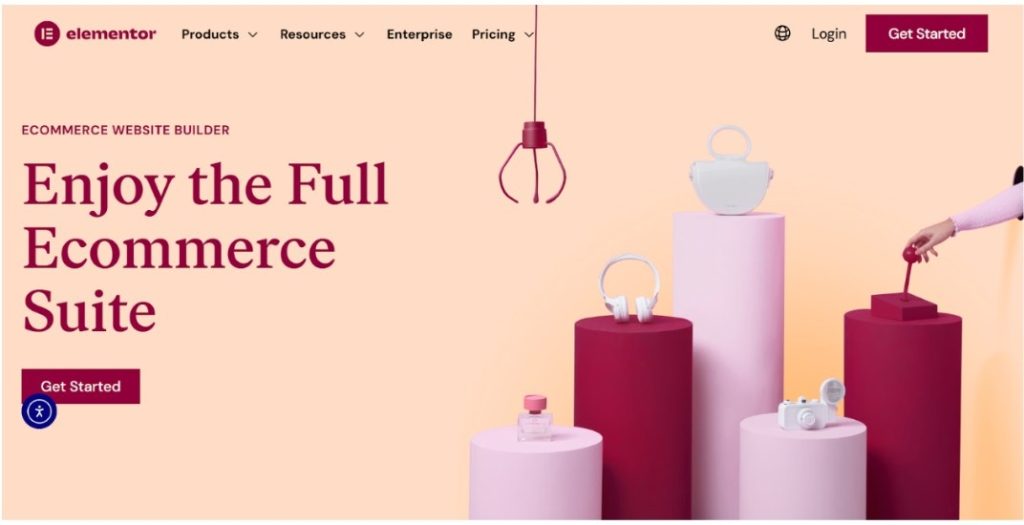
It includes key features such as product pages, promotional pop-ups, product archives, and WooCommerce integration. The platform also offers various e-commerce widgets, no-code customization options, and marketing tools to boost sales and enhance the customer experience.
9. Mobile Responsiveness
Webflow ensures a fully responsive design by default, with the ability to customize layouts for desktop, tablet, and multiple mobile screen sizes. Designers can hide elements, tweak styles, and fine-tune spacing for each device, enabling pixel-perfect, code-free control over how a site appears across all screen types.
Elementor provides advanced mobile design tools using custom breakpoints that let you design for up to 7 Device types. You can add, adjust, and preview breakpoints to ensure pixel-perfect responsiveness. Features like absolute positioning, motion effects, and responsive menus ensure optimal layouts across all screen sizes.
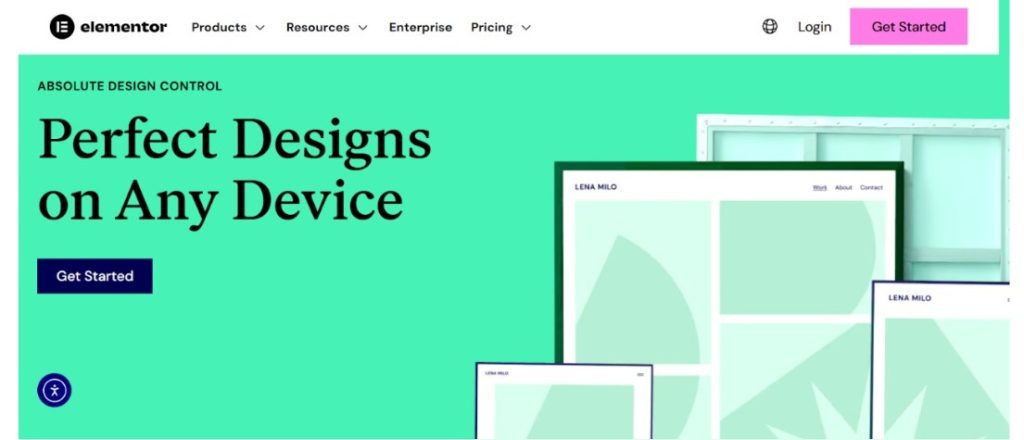
10. Customer Support
Webflow provides customer support through email, a Help Center, and Webflow University for self-guided learning. Enterprise customers can now access live phone support for urgent or complex issues, available Monday through Friday from 6:00 AM to 6:00 PM, by scheduling through their Customer Success Manager.
Elementor provides tiered support, with Pro users accessing standard help via email, chat, and ticketing. Premium options, such as Platinum Support, offer priority access through WhatsApp, live chat, or a dedicated manager. Help Center, video tutorials, and community forums also support users at every skill level.
Pros and Cons: Webflow vs Elementor
Webflow offers advanced design control but has a steep learning curve, while Elementor is user-friendly but less flexible.
Webflow Pros
- Enables pixel-perfect design control with a visual canvas that supports custom code.
- An integrated CMS enables easy content creation, editing, and scalable publishing.
- Built-in AI tools and analytics help optimize SEO, conversions, and user experience.
- Secure, fast hosting with collaboration features supports growth without sacrificing performance.
Webflow Cons
- Higher learning curve requiring web design knowledge.
- More expensive pricing compared to competitors.
Elementor Pros
- User-friendly drag-and-drop interface for beginners.
- Extensive WordPress plugin ecosystem compatibility.
- Affordable pricing options for different budgets.
Elementor Cons
- Requires separate WordPress hosting and maintenance.
- Limited functionality without the premium version.
Who Provides The Best Tools Between Webflow And Elementor?
Webflow excels in providing professional design tools and complete website solutions. It’s ideal for designers, developers, and agencies requiring advanced customization and control.
On the other hand, Elementor offers better accessibility and ease of use for beginners and WordPress users, with the flexibility to cancel your Pro subscription at any time if needed. It provides extensive customization options within the familiar WordPress environment.
Webflow vs Elementor: Which Platform To Choose?
Webflow is a great choice if you want a complete package that offers hosting, strong design features, and fast performance. It’s ideal for individuals with some design or coding skills.
This platform gives you full creative freedom, making it ideal for users who are ready to learn and build high-quality, professional websites with advanced customization and control.
In contrast, Elementor works well if you enjoy using WordPress and want a simple, user-friendly design tool. It’s beneficial for beginners and non-tech users.
Freelancers and small business owners will find Elementor easy to manage. It offers flexible pricing and access to WordPress plugins, although hosting and maintenance need to be handled separately.
Suggested Reads:
Final Thoughts: Elementor Is Better For Beginners Than Webflow!
Elementor offers an easier learning curve and benefits from WordPress integration. WordPress integration benefits Elementor. On the other hand, Webflow offers superior design flexibility and all-in-one convenience, but requires a higher level of technical knowledge.
Both platforms create professional websites effectively. Consider your technical skills, budget, and specific requirements when choosing between these website-building solutions.
For beginners, start with Elementor’s free version. For professionals, invest in Webflow’s advanced capabilities and streamlined workflow.
FAQs
Webflow is better suited for professional designers and developers, while Elementor is more suitable for beginners and WordPress users.
Popular alternatives include WordPress with Gutenberg, Wix, Squarespace, Framer, Bubble, and traditional page builders like Divi or Beaver Builder.
Elementor is designed for beginners, offering an intuitive drag-and-drop interface and live editing capabilities.
Both are visual website builders, but Webflow is a platform that includes hosting, while Elementor is a WordPress plugin.
Elementor works best with modern browsers, such as Chrome, Firefox, Safari, and Edge. Chrome is often recommended for optimal performance and compatibility.
Webflow is better for users wanting complete website solutions, advanced design capabilities, and built-in hosting.
